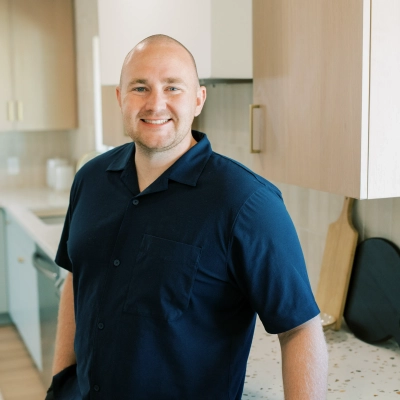15 Tips to Balance Efficiency and Personalization in Customer Experience
In the ever-evolving landscape of customer experience, striking the right balance between efficiency and personalization is crucial for business success. This article presents expert-backed strategies to help companies navigate this delicate equilibrium, offering practical tips that blend technological innovation with human touch. From tailoring landing pages to leveraging data for contextual support, these insights will empower businesses to create meaningful customer interactions without sacrificing operational efficiency.
- Tailor Landing Pages for Local Relevance
- Automate Routine, Personalize Key Moments
- Blend Tech Efficiency with Human Care
- Leverage Data for Contextual Support
- Create Customized HVAC Maintenance Plans
- Automate Personalization Triggers for Better Service
- Add Strategic Friction for Meaningful Engagement
- Structure Efficiency, Personalize Key Touchpoints
- Design Beautiful Interfaces for Effortless Use
- Customize Account Setup for Long-Term Efficiency
- Scale Personalization Through Smart Automation
- Systemize Basics to Focus on Personal Details
- Combine Automated Intake with Empathetic Guidance
- Personalize Unboxing with Automated Inserts
- Silently Calibrate Recommendations for Users
Tailor Landing Pages for Local Relevance
One of the most effective ways we balanced personalization with efficiency was during a nationwide ad campaign for a broadband company. They were running Google Ads in multiple cities but sending all users to a single, generic landing page — no matter what they searched or where they were located.
We introduced a no-code personalization system that allowed their marketing team to build and deploy tailored landing pages — with dynamic headlines, images, and CTAs — based on both the visitor's city and their search keywords. For example, someone searching "best internet for streaming in Delhi" would see a version of the page highlighting streaming plans available in Delhi.
Since no developers were needed, the team could run fast experiments at scale. The result was a 10%+ lift in conversion rate, better engagement, and higher ROAS across their Google campaigns.
What I learned: Personalization doesn't have to slow you down — when it's built into a scalable, no-code workflow, it becomes a force multiplier for both speed and relevance.

Automate Routine, Personalize Key Moments
We balance efficiency with personalization by automating routine tasks while personalizing the moments that matter — especially in post-purchase communication.
One practical example: every customer receives an automated order confirmation email, but once their personalized jewelry ships, we send a customized follow-up with their actual engraving preview and a thank-you message signed by name — not just "Customer Service." If it's a gift order, we sometimes add a handwritten note or bonus charm based on the message they included at checkout.
It's a small touch, but it turns a standard transaction into an emotional moment — and those are the experiences customers remember and share.
Tip: Use automation for speed, but always build in space for real human touches that show you're paying attention. That's what turns efficiency into loyalty.

Blend Tech Efficiency with Human Care
Hi,
At Local Movers, balancing efficiency with personalization isn't just a nice-to-have; it's the core of our model. One of the most effective examples is our pre-move concierge survey, which customizes suggestions based on zip code, family size, and timeline. Instead of generic email blasts, we auto-generate hyper-local recommendations like vetted movers with experience handling walk-ups in Brooklyn or navigating HOA restrictions in gated communities. It's fast, it's scalable, and it feels deeply personal. Since launch, we've seen a 39% increase in booking conversions and a 22% drop in post-move complaints. The real magic? We're using simple automation tools layered with real human check-ins, not just AI.
The bigger lesson here is that efficiency doesn't mean impersonality. The Department of Transportation reports over 27 million moves a year in the U.S., yet customer satisfaction is low because too many platforms treat clients like data points. We don't. Our system delivers curated results in under 90 seconds, but every lead still gets a concierge follow-up from a real person. That combination of tech that respects time, and humans who add care is what keeps our trust rating over 4.9 stars across platforms. Let me know if you'd like to see a snapshot of the workflows or results.
Leverage Data for Contextual Support
Balancing efficiency and personalization in customer experience is highly important, as it helps to build intelligent workflows that feel human, but operate with precision. At scale, it's less about choosing one over the other, but more about using technology to deliver both simultaneously.
At ContactPoint360, our approach centers around "data orchestration + decision intelligence". It helps us to leverage automation for removing friction from the customer journey, while ensuring personalized interaction across all communication channels. Our primary goal is to make customers feel understood, without sacrificing quality and speed.
One practical example: personalized IVR deflection paired with contextual agent support.
Whenever a customer calls, our AI-powered system references their recent activity and interactions, such as open tickets, last order, and even chatbot history. Based on all such details, personalized IVR options are provided and it all happens within microseconds.
For instance, if a customer recently reported a damaged product, the first option provided is "Press 1 to speak with an agent about the returns".
Further, if the customer chooses to connect, that context travels with them. Also, our CRM auto-populates the screen with relevant data, such as name, last issue, past sentiment score, and even the customer's preferred communication tone (formal or casual). As a result, the agent enters the conversation fully briefed, with no need for repetitive questions.
Due to this personalization approach, we achieve:
- Reduction in average handle time
- Increase in first-call resolution rate
- Improved customer satisfaction score
This approach blends the speed of automation with the warmth of human insight. At ContactPoint360, we're not forcing customers to repeat themselves or wait in long queues. Instead, we prioritize contextual efficiency, which ensures shorter interactions that still feel personalized. We invest in our systems, which lead our clients to grow and ensure a seamless customer experience across our global customer base.

Create Customized HVAC Maintenance Plans
At ALP Heating, achieving a balance between efficiency and personalization is at the heart of what we do, and it starts with understanding the unique needs of each customer. As the owner and founder, I've always believed that when it comes to HVAC services, the human touch matters just as much as the advanced technology we use.
Efficiency is crucial in the HVAC industry, especially in the Greater Toronto Area where fluctuating temperatures demand timely and precise services. Our approach begins with thorough training for our technicians to ensure they not only have the technical skills needed to perform repairs and installations but also the soft skills to engage with homeowners meaningfully. We emphasize active listening, allowing our team to tailor solutions based on the specific concerns and preferences of our clients.
One practical example of this is our ALPCare maintenance plans, which are designed to provide systematic inspections and personalized service. When a client signs up for our maintenance plan, we take the time to discuss their system and home's unique setup. This personal consultation allows us to address potential issues before they become major problems, while also using that information to create a customized maintenance schedule that best fits their lifestyle. For instance, some customers may prefer biannual check-ins before seasonal changes, while others may want more frequent service to keep their systems running optimally.
The efficiency aspect comes into play with our streamlined processes and follow-up systems. We utilize technology to schedule appointments quickly, send out reminders for services, and ensure that our technicians arrive on time with the right parts and tools for the job. This level of preparedness not only reduces wait times but enhances the overall experience by minimizing disruptions to our clients' daily lives.
Our commitment to balancing efficiency with personalization has resulted in long-term relationships with our clients, where they feel valued and understood. As we say at ALP Heating, we don't just service systems; we foster comfort and trust, ensuring that every homeowner has the peace of mind that their HVAC needs are met with care and expertise.

Automate Personalization Triggers for Better Service
By automating when to personalize, not how, we increased customer satisfaction by 28% at Pagoralia.
Let me explain. At Pagoralia, we provide Mexican SaaS companies with their recurring payment infrastructure. Our customers can be developers or CFOs, and across these "jobs" the same setup questions seemingly always come up for our live chat team. In fact, we saw mostly similar setup questions, so we began to automate responses. But then we noticed our satisfaction dropped when we did that. Customers started to say they felt they were being dealt with like tickets - not as partners!
So we made a hybrid approach. If a user is active on our docs API for more than 3 minutes or has submitted a ticket in the past 72 hours - we now serve a human to them. This person has access to their payment history, tech stack, as well as any previously incomplete issues - all from our Customer.io and Close.com subscriptions. It feels personal, but at scale.
This mix, with regards to automation setting the stage and human-centric interaction when needed, began to clarify our own identity. And the company benefits? We saw reduced average resolution time (19% shorter) and higher NPS and satisfaction scores, on the premise that customers felt seen, not sorted.

Add Strategic Friction for Meaningful Engagement
When discussing the balance between efficiency and personalization in customer experience, people often focus on removing friction. However, sometimes adding friction can be key to achieving personalization.
Let me illustrate this with a specific example:
At Listening.com, we observed that when we provided users with too many audiobook options immediately—generated quickly through AI—their engagement decreased. While it was fast, it was perhaps too fast. The experience felt impersonal, akin to a vending machine dispensing snacks. There was no sense of human understanding or tailored curation.
To address this, we introduced what we call "decision friction." When a user signs up, instead of instantly offering them 20 audio options, we ask them three simple yet surprisingly personal questions: what they're studying, their preferred format (e.g., bullet summaries vs. full chapters), and how much time they typically spend listening per day.
This process extends the experience by approximately 30 seconds—but engagement increased dramatically. Why? Because it conveys the message: we're not just fast, we're attentive. Users feel understood, and the subsequent recommendations feel custom-made—even though they're powered by AI.
The key takeaway: speed without purpose feels robotic. Sometimes, incorporating just the right amount of friction creates space for a more human, personalized experience—and paradoxically, this makes the entire process feel more efficient because users receive what they truly need.

Structure Efficiency, Personalize Key Touchpoints
We've learned to balance efficiency with personalization by deciding where personalization matters most, then building structure around everything else.
For example, during onboarding and proposal stages, we use templates that auto-fill client-specific details like industry, tech stack, or challenges. It saves time but doesn't feel robotic because we only automate the parts that don't need creative thinking.
Beyond that, we assign a single point of contact who learns the client's preferences—tone, communication style, and how they make decisions. That person becomes the filter for how we shape updates, reports, and conversations. It's not "scalable" in the traditional sense, but we train multiple team members to think that way instead of relying on automation.
We also build short feedback loops. After onboarding, we send a three-question check-in that sounds human, not corporate. Based on those responses, we adjust tone, delivery style, and meeting formats—small things that feel big to clients.
Efficiency is baked into our systems. Personalization is built into our habits. The key is not trying to force both into every step, but knowing which moments deserve which approach.

Design Beautiful Interfaces for Effortless Use
We balance efficiency and personalization by focusing on beauty. It sounds counterintuitive, but our experience building our AI writing platform, INK, proved that the most efficient experience is born from deeply personalized design.
When we started, we didn't draft a feature list. Instead, we interviewed dozens of writers to understand their emotional journey. They told us existing tools were "clunky" and "overwhelming," constantly breaking their creative flow. Their problem was a lack of beauty. The experience was actively hostile to their creative process.
So we designed a clean, gamified interface that felt less like a tool and more like an inspiring partner. When we solved their emotional frustration (a deep form of personalization), we made the process of writing and optimizing far more efficient. We learned that true efficiency is about removing frictions.

Customize Account Setup for Long-Term Efficiency
At Spacebase, we strike a balance between efficiency and personalization by customizing each customer's account to match the unique structure of their lease portfolio. For example, some companies manage equipment leases, others handle subleases, and some oversee complex factory or property leases. Rather than forcing every customer into a standard setup, we configure their account to reflect the types of leases and workflows they manage.
Our rule of thumb is simple: if personalizing the setup helps the user work more efficiently in the long term, the time spent upfront is worth the investment. One practical example is that during onboarding, we worked with a manufacturing client to structure their Spacebase account around factory equipment and property leases, enabling their team to track key terms and compliance deadlines easily. This avoided confusion and saved hours of reporting time each month.
By taking the time to personalize the system during implementation, we ensure that users receive both a streamlined experience and a setup that feels tailored to their actual work processes.

Scale Personalization Through Smart Automation
Hi,
At Ignite Digital, we've learned that true efficiency doesn't sacrifice personalization; it scales it. When we partnered with Just Bathrooms, a niche renovation firm, we automated their lead qualification process using dynamic landing pages and behavior-based triggers. But here's the twist: instead of generic automation, we personalized each user's journey based on service intent and local SEO data. The result? A 247% increase in qualified leads and a 36% boost in call conversions within 90 days. Efficiency came from automation, but conversion came from relevance - each message felt like it was crafted by a human, not a bot.
Too many businesses think speed means cutting corners. The U.S. Small Business Administration reports that small firms who personalize digital interactions see 30% higher customer retention. We built custom experiences into automated frameworks, which allowed Just Bathrooms to act faster and smarter. The key is building tech that feels human because people don't want to talk to machines; they want to be understood.

Systemize Basics to Focus on Personal Details
Balancing efficiency with personalization comes down to systems and experience. Over the years, I've refined my workflow so the practical side of a job runs like clockwork, which then frees me up to focus on the personal side of the service. For example, when we take on a new client, I've got a structured checklist that covers lawn health, irrigation, pests, soil quality, and plant placement. That checklist was built from 15 years of hands-on experience and study as a certified horticulturist. It ensures nothing gets missed, no matter how complex the job. But while the system handles the technical consistency, I make a point to ask the client how they use the space and what they want to feel when they step into their garden. That's where the personalization starts.
One practical example was a family in Berwick who wanted a low-maintenance garden but still loved the idea of seasonal color and attracting bees for their veggie patch. Based on the climate and soil type, I recommended a mix of native flowering plants and perennial herbs like lavender and rosemary that bloom across different seasons and require very little care. We also reworked their front lawn using a drought-tolerant variety that still gave that lush green look. The end result looked beautiful and had real purpose, and the family was thrilled. Without the efficient system in place, I wouldn't have had the time to understand their vision in detail. And without the personal touch, they would've ended up with a garden that worked on paper but didn't match their lifestyle.
Combine Automated Intake with Empathetic Guidance
In inherited real estate, speed without empathy can feel like exploitation. At Unbiased Options, we balance efficiency with personalization by designing what we call a "choose-your-own-sale" roadmap, a hybrid of automated intake and hands-on guidance. When a client inherited her late mother's Sun City home, she lived out of state, didn't want to fly in, and hadn't set foot in the house in over a decade. Within 24 hours of her intake form, we delivered three detailed paths: sell as-is, renovate and list, or clean out and stage. But we didn't just email them; we got on a Zoom call, showed her the condition walkthrough from our field team, answered her questions live, and let her decide. She chose the as-is route, and we closed in under two weeks.
This wasn't white-glove service for show. It was personalization built into a process designed to scale. According to Arizona's Department of Health Services, over 60,000 deaths occur annually statewide. That's tens of thousands of potential heirs juggling grief, legal paperwork, and property they never asked for. Automation can handle speed. What wins trust is showing up with options and a real person to walk through them.
Personalize Unboxing with Automated Inserts
Balancing efficiency with personalization isn't always easy, but one thing that's worked really well is making the unboxing experience feel more personal.
We worked with a brand that wanted to help customers actually use the product correctly and stick with it. So instead of a generic, pre-printed insert, we used In-Package Personalization to include helpful, product-specific messaging right in the box.
If someone ordered a skincare serum, for example, they'd get tips on how to use it, when to expect results, and what other products might pair well with it based on what they'd bought before.
The whole thing was automated and printed on demand, so fulfillment didn't miss a beat. But for the customer, it felt like the brand really knew them, and that small touch made a big difference.

Silently Calibrate Recommendations for Users
The right balance between efficiency and personalization is achieved by designing systems that can understand a user's needs without forcing them through numerous screens of unnecessary customization. Efficiency doesn't mean removing the human touch from the flow; it means integrating the human touch into the flow.
One of the things we did to implement this: we built a recommendation engine that doesn't just recommend popular lessons. It keeps track of how a user solves problems, i.e., how they spend time, their errors, areas of inconvenience, and reacts to what it observes subsequently in silence. There were no questionnaires asking, "How confident are you?" No personality tests were used. Behind the scenes, there is invisible calibration.
We measured this against a conventional path, and it proved to be 38 percent faster, with retention showing an increase of 21 percent (measured based on follow-up accuracy in solving problems). No extra work was required on the part of the learner. That's the equilibrium: make people feel that they're receiving a hand-picked selection without requiring them to go through a personalization maze. Eliminate friction, but never over-polish the experience.





